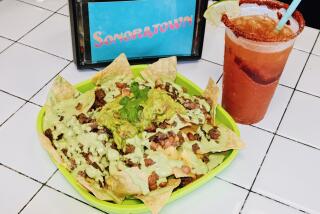Shake-up in latte land
- Share via
It’s a drink so simple that probably the most amazing thing about it is that it took this long to cross into the mainstream where smoothies, milkshakes and Frappucinos flow.
Here’s how simple: Add fresh fruit to milk and blend.
What you get is a licuado (pronounced lee-KWA-doh), traditionally blended for breakfast, light meals and snacks in Latin America, but now also being whipped up and served in restaurants in Hollywood and L.A.’s trend-sensitive Westside.
“This is as hot now as the music of J. Lo and Enrique Iglesias,” says Los Angeles chef Toribio Prado, whose family owns the Cava, Prado, Cha Cha Cha and Confete restaurants.
So hot that it’s caught the attention of the California Milk Processor Board (the people who brought you “Got Milk?”), which approached Prado about creating new licuado recipes that would appeal to American taste buds. Already ads featuring licuados are running in national magazines like In Style, People and Martha Stewart Living -- they show a blender with fruit in it just waiting for milk, and they direct readers to the “Got Milk?” Web site, where Prado’s recipes are listed.
The drinks can be made with whatever fruit is on hand -- but popular choices include mango, papaya, guava, apple, mamey (a football-shaped tropical berry), banana and berries.
Long a staple in homes and restaurants in East L.A. and in Latino communities around the country, the drink is also popularly served in small licuado bars like the one at Sonora Bakery in East Los Angeles.
“I come in every morning on my way to work to get my strawberry licuado and my coffee because it’s fast, very tasty and I know it’s good for me,” said Jose Perez, 30, a furniture salesman who grew up drinking licuados in Mexico. “I like to make them at home, too, but it’s faster to just come in here.”
Jeff Manning, executive director of the California Milk Processor Board, is always looking for new ways to market milk to consumers. “There are a lot of ways the Hispanic community uses milk that the general market doesn’t,” said Manning, citing flan, tres leches cake, horchatas (rice-based drinks) and licuados. With licuados, he sees an opportunity to cross cultural lines to expand milk’s appeal to adults and children. “Kids get very tired of milk. Instead of giving them a Gatorade or Coke, licuados are full of flavor and yet it’s still eight ounces of milk.”
Prado, who came to California from Mexico when he was 14, sees the drink as a way to share a part of his heritage. “We are a refined race and culture, but many of our traditions were left in our homelands when we came here,” he says. “It’s a beautiful thing to be able to introduce something like this to the American palate.”
Although licuado is a contemporary name, the drink itself has been consumed in Latin America since the 18th century. Before the invention of the manual or electric blender, the instrument of choice was a mortar, a wood or marble bowl used for mashing solids until pureed. Unlike with the modern blender, it was essential with the mortar that the fruit be very ripe to make it easier to mash.
The taste, style and consistency of a licuado is very much a reflection of who is blending the drink -- and sometimes goes way beyond its simple roots.
Prado has developed 16 recipes that range from classic fruit-and-milk-based licuados to adventurous concoctions that call for peanut butter and peppermint. His “Fiesta Licuado” contains orange juice, pineapple juice and peaches; his “Icy Pink” consists of strawberry ice cream and guava syrup. “Sometimes I even put liquor in them and send them as shots to the tables. You can get very creative with this beverage.”
The drinks are now on the menu at Cha Cha Cha on Virgil Avenue and soon will be added at Confete on Santa Monica Boulevard. And Prado plans to open licuado bars in malls elsewhere in Southern California -- he envisions shoppers browsing with licuados instead of lattes in their hands.
“I feel a bit ridiculous mixing shakes, but I’m proud of representing my culture this way,” Prado said. “In Mexico, licuados are a cultural staple. You drink them with your family and your friends. They’re refreshing, but they’re also very nutritious.”
Also called batidos (bah-TEE-dohs), licuado mixes are sold in supermarkets, but, says Manning of the milk board, those miss the mark by leaving out the most important element of a licuado: its freshness and innate nutritional value.
“This is why we’re sticking to the traditional preparation” in promoting the drink, Manning said. “One of the magical things about making licuados at home is that you can basically make everything you want. My wife is a chocolate person. She’ll start with a banana and, lo and behold, in will go three or four ounces of chocolate and a bit of cream and the whole thing gets pretty indulgent quickly. The traditional licuado is very healthy.”
Mexican restaurants throughout Los Angeles, like El Burrito on Hollywood Boulevard, have offered the traditional fruit-and-milk licuados for many years. In downtown L.A., Roberto Ceballos makes a good living selling sandwiches, fresh juices and licuados at his tiny Doreen’s Cafe.
Rachelle Williams, human resources director at the Mexican American Legal and Educational Defense Fund, stops in at Doreen’s for papaya, mango and strawberry licuados during her lunch hour several times a week.
The reason, like the drink itself, is simple, she says: “It satisfies the sweet tooth, but I feel it’s nutritious and healthy ... and it tastes very good.”
More to Read
Eat your way across L.A.
Get our weekly Tasting Notes newsletter for reviews, news and more.
You may occasionally receive promotional content from the Los Angeles Times.









